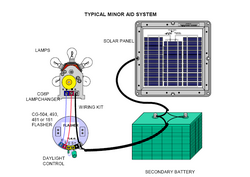Engineering:Automatic lamp changer
An automatic lamp changer (or lampchanger) is a device used to ensure that a navigational light such as a marine lighthouse or aero beacon stays lit even if a bulb burns out. Numerous types exist. The common design elements are an array of two or more lamps (or bulbs), installed on a mounting which can rotate to various positions. Each position brings a different lamp into the focal point of an optical assembly. Since signal and navigational lights use sophisticated optics to focus the beam, lampchangers are designed to position the new bulb at the focal point with high precision. The device automatically detects when the currently active lamp has ceased to function and moves the next lamp into place.
History
The automatic lampchanger was invented by Charles Wallace and patented in 1928.[1] This original model held two headlight lamps from a Model T automobile. The United States Lighthouse Service had these in common use by the 1930s, as they moved to convert all navigational lights to electricity.
Types in current use
Lamp changers in current use may have two, four, or six lamps and use either a spring-loaded mechanism or an electric motor to change lamps when required. They are used in aerodrome beacons and marine navigational aids.[2][3][4][5][6][7]
References
- ↑ "APL1297A Lampchanger". Pharos Marine Automatic Power. http://www.automaticpower.com/products/catalog/APL-1297A.pdf.
- ↑ "Seeing The Light - The DCB-224 Aerobeacon". Terrypepper.com. http://www.terrypepper.com/lights/closeups/illumination/aerobeacon/dcb224.htm.
- ↑ "Aids To Navigation | The Carlisle & Finch Co". Carlislefinch.com. http://www.carlislefinch.com/marine/aidsnav.htm.
- ↑ "Commandant Notice 16500". United States Coast Guard. http://www.uscg.mil/directives/cim/16000-16999/CIM_16500_17.pdf.
- ↑ Office of Civil Engineering United States Coast Guard (January 2001). "Specification for 12VDC, Six-place Lampchanger for Maritime Aids to Navigation, Type CG-6P". Washington, D.C.. http://www.uscg.mil/hq/cg4/cg432/docs/specifications/195-H.pdf.
- ↑ "Lampchanger E390". Ekta.ee. 2011-03-01. http://www.ekta.ee/html/e390.htm.
- ↑ "Lampchanger PA2 Series & Diffuser". Pelangi. http://www.pelangi.co.uk/pdf/s03/Pa2-diffuser.pdf.
 |




